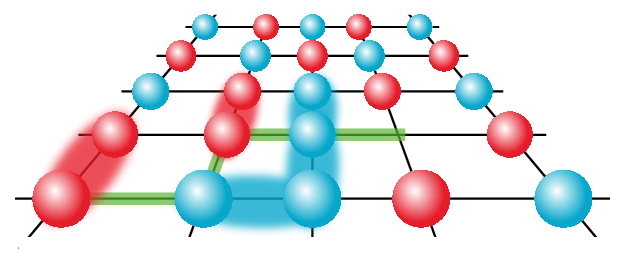Stop motion of a hole in a quantum magnet
New paper in Physical Review Letters

Researchers at the Center for Complex Quantum Systems at Aarhus University and the Max Planck Institute for Quantum Optics near Munich, Germany successfully explain recent results from an experimental group at Harvard University. High-temperature superconductivity is one of the greatest challenges in contemporary physics. A thorough understanding of the phenomenon promises a systematic development of more efficient, resilient and flexible materials that could for example be used for loss-less power transmission lines.
Disturbance in the checkerboard pattern
While this still remains an elusive goal, modern quantum simulation experiments have found a new way to gain insights into this exciting problem. In detail, particles are made to sit in a square grid. The particles can be magnetized either up or down in two internal states called spin. Neighbouring spins tend to align in opposite directions forming an anti-ferromagnetic checkerboard. When a single particle is taken out of the grid, the remaining ones are able to hop on to the vacant site one at a time (see figure). In this way, the vacancy -- or hole -- effectively moves through the lattice, and, consequently, disturbs the checkerboard pattern. Recent experiments at Harvard University used these capabilities to see how the hole moves through the system. In practice, they let the hole spread out for some time, after which they take a picture of where it was. After thousands of runs of the experiment, this leads to a stop motion movie of the hole. In this way, they revealed that fast initial motion of the hole is significantly reduced at longer times.
Novel insights in an important phenomenon
These remarkable new experimental results allowed Kristian Knakkergaard Nielsen, now PostDoc at the Max Planck Institute for Quantum Optics, in collaboration with Thomas Pohl and Georg Bruun at Aarhus University to develop a new theory for this process. The central insight of this work was that the hole initially moves without realising that there is a magnetic checkerboard around it. As the hole eventually 'opens it eyes' to its surroundings, it starts to become dressed by the disturbances it makes in the magnetic checkerboard. Eventually, the hole and the disturbances of spins have to travel together as en entity, a so-called quasiparticle, and can only do so at greatly reduced velocities. These quasiparticles are believed to be a key ingredient in the fundamental properties of high-temperature superconductors, and may very well be the carriers of the associated supercurrent. The interplay of these groundbreaking experiments and the novel theoretical insights, thus, allowed a new and important understanding of this important phenomenon.
In the future, the researchers hope to explore the properties and dynamics of such holes in even more exotic phases of matter, as well as how two holes can bind together to form highly exotic molecules dressed by disturbances in the magnetic checkerboard they reside in.
The article can be found here: https://doi.org/10.1103/PhysRevLett.129.246601
